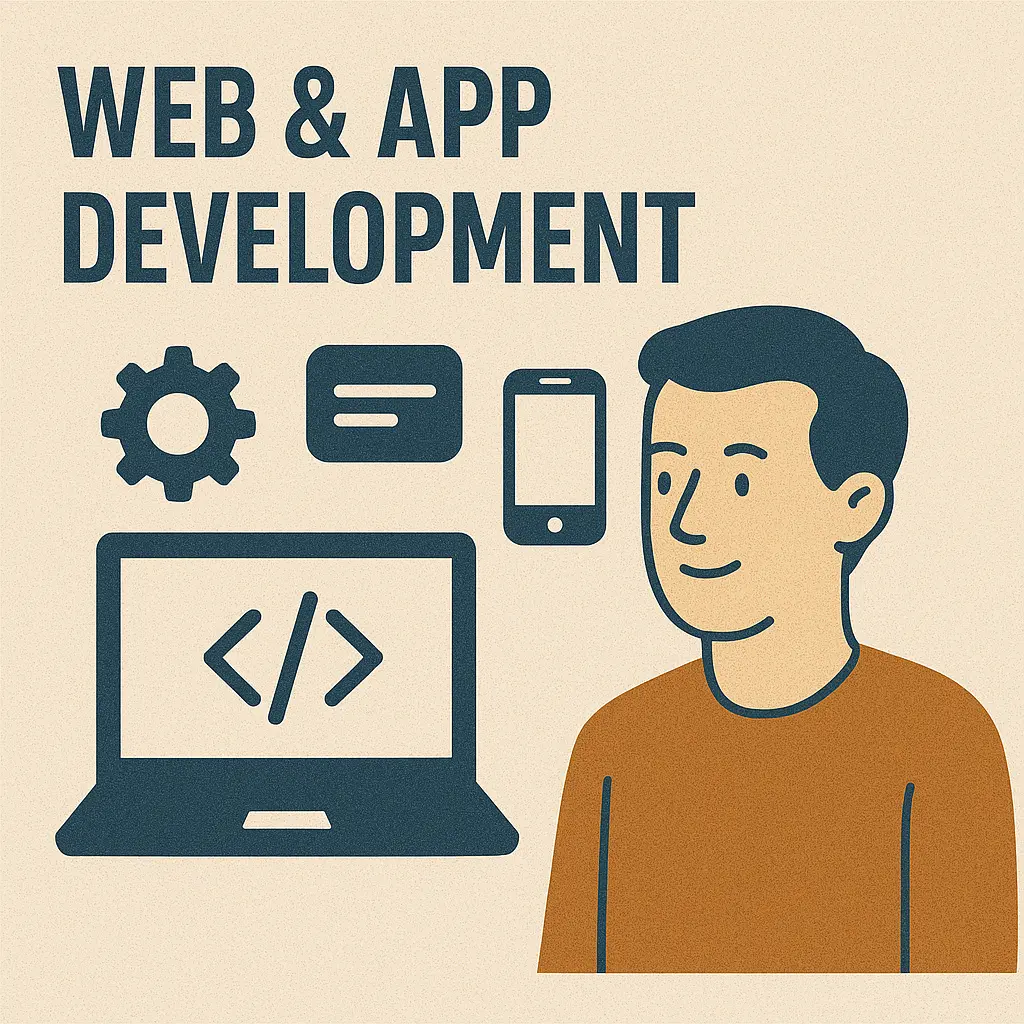By Junaid Imdad, Blogger & Digital Experience Strategist
2025 is fast approaching and mobile apps have evolved beyond mere digital accessories for businesses; they’ve become powerful platforms for delivering value to customers, cultivating customer loyalty, and opening up new revenue streams. But for any startup with big ideas or small company looking to increase digital footprint, one question always remains: What does it cost to build a mobile app in 2025?
The answer is: it depends. But don’t worry—I can break it down without technical jargon or false promises. After five years of blogging and consulting on tech projects, I’ve seen firsthand how the cost to build a mobile app in 2025 can vary widely based on features, platforms, and business goals. App development has evolved significantly, offering more options to stay within your budget while still delivering modern, high-performing apps.
Understanding the Cost to Build a Mobile App in 2025
In 2025, the cost of developing a mobile app is shaped by a variety of factors, including how complex the app is, the features it offers, the quality of its design, its scalability, and the platforms it’s designed for—whether that’s iOS, Android, or both. For a straightforward app with basic features like static content, a simple user interface, or limited interactions, you might be looking at a price tag between $5,000 and $20,000. These are usually apps created for MVPs (Minimum Viable Products), internal purposes, or early-stage startups.
On the flip side, as the functionality ramps up—especially with the addition of real-time features, AI capabilities, payment systems, data analytics dashboards, or advanced user personalization—the costs can soar. For instance, mid-tier apps that include dynamic content and user authentication typically fall in the $20,000 to $50,000 range. Meanwhile, more advanced apps that incorporate AI, real-time chat or video streaming, geolocation tracking, or intricate backend systems often start at $60,000 and can easily exceed $150,000.
When it comes to figuring out the cost of building a mobile app in 2025, the price tag can really depend on who’s doing the work. Freelance developers might offer more budget-friendly options, but they often don’t have the same project management capabilities as a full-service agency. Onshore agencies usually provide top-notch services, but that comes with a steeper price. On the other hand, offshore development teams can save you a significant chunk of change—up to 40–60%—but they do require good communication and oversight to maintain quality and consistency.
The good news is that new technologies like no-code and low-code platforms, along with AI-powered development tools (think GitHub Copilot or ChatGPT), and modular frameworks are making it easier and more cost-effective for startups and small to medium-sized businesses to create fully functional apps without compromising on quality. These advancements are breaking down barriers, enabling more entrepreneurs to turn their ideas into reality with fewer resources.
In short, grasping the costs involved in building a mobile app in 2025 is crucial—not just for budgeting, but also for prioritizing features, estimating timelines, and allocating resources effectively. Whether you’re developing a customer-facing retail app, an internal business tool, or the next big social media platform, understanding where your money goes will help you make smarter investments and achieve better returns.
Factors That Affect App Development Cost
Before assigning an app’s cost a price tag, let’s consider what factors affect its expenses:
1. App Complexity
- Complex App: Between $10K-30k for simple calculator or note taking apps
- Moderate Apps (e.g. fitness tracker or e-commerce): $30,000-$80,000
- Complex App (e.g. ridesharing or AI-powered marketplace): $80,000-$300,000.
2. Platform
- Platform only available on iOS or Android: Reduced upfront costs
- Cross-platform (Flutter/React Native) development: Saves long-term costs while expanding reach through one codebase.
3. Design and User Experience (UX)
In 2025, users are looking for nothing short of sleek, intuitive, and user-friendly interfaces. The visual and interactive design of an app has become a key player in how engaged and satisfied users feel. When it comes to mobile app design, you could be looking at a price tag ranging from $5,000 to $25,000, depending on how customized, detailed, and unique you want it to be.
As you consider the cost of building a mobile app in 2025, it’s crucial to understand that design goes beyond just looking good—it’s a major factor in performance. A visually appealing and seamless user interface (UI) can really boost user retention, lower bounce rates, and extend session times. In a world where users decide in a heartbeat whether to keep or ditch an app, the design can truly make or break your success.
Putting money into smart UI/UX design from the get-go can save you from future expenses related to redesigns, usability hiccups, and negative app reviews. So, as you plan your budget and figure out the cost of building a mobile app in 2025, make sure to set aside enough resources for the design phase. It’s not just a nice-to-have; it’s a fundamental part of your app’s value and long-term success.
If you want to get info about UI/UX design, simply click on it.

4. Features and Functionalities for Effective Planning
Each feature that increases costs:
- Login and Authentication Services from $1,000-$5,000 per session are offered.
Real-time Chat: $5,000-$15,000
- Geolocation: $3,000-$10,000
- Payment Gateways: $3,000-$10,000
- Integration of AI/ML: $10,000-$50k+
Push notifications, AR features, multilingual support – each adds their part to the final bill.
5. Backend Infrastructure
When you’re trying to figure out how much it will cost to build a mobile app in 2025, one of the biggest factors to consider is the backend infrastructure. This encompasses everything from servers and databases to admin dashboards and the APIs that keep the app running smoothly behind the scenes.
If your app needs strong server-side logic, real-time data syncing, secure user authentication, or third-party integrations, you can typically expect to spend anywhere from $10,000 to $60,000—or even more in some cases. If your app requires complex data storage, caters to millions of users, or includes advanced features like machine learning, geolocation services, or detailed analytics dashboards, be prepared for those backend costs to increase. Scalability, uptime, and data security are also crucial, especially if you’re aiming for long-term growth or working in a regulated industry.
In short, the more features your app relies on behind the scenes, the more you’ll need to invest in a reliable and scalable backend.
6. Development Team Location
- In US/Canada: $100-$250 per hour
- In Europe from $60 to $150 an hour (Pakistan, India and Philippines).
- In Asia the cost per hour varies between $20 and 80/hour
Outsourcing to offshore development teams can really help cut down the costs of building a mobile app in 2025. However, it’s crucial to have strong communication and project management in place to keep everything on track and ensure the project meets your expectations.

7. Maintenance & Updates
After you launch a mobile app, the journey is just beginning—there’s still a lot to do. In 2025, keeping your app running smoothly is essential for a successful strategy. This means regular updates, fixing bugs, monitoring servers, tweaking APIs, and making sure it works with the latest operating system versions. Generally, you should plan to spend around 15–20% of your initial app development budget each year on maintenance.
For instance, if your app cost $100,000 to create, you’ll want to set aside $15,000 to $20,000 annually just to keep everything in tip-top shape. This could involve patching up security holes, enhancing performance, resolving crashes, and incorporating user feedback through new features or adjustments.
If you ignore regular maintenance, it can end up costing you more down the line. Even the most beautifully crafted app can start to feel outdated or unreliable without ongoing care, which can lead to negative reviews, decreased user retention, and frustrated users who might decide to uninstall and never return.
Real-World Example Scenarios
Let’s put this all into perspective by looking at real-world project types:
1. Local Restaurant Ordering App
Features of Menu, Order, payment and notification system
Platform: Android only and estimated cost between $20,000-35,000
2. On-Demand Service App (Like Uber)
Features: Geo-tracking, real-time matching, payments and reviews.
Estimated Budget Range: $100,000-$250,000.
Timeline: 6-12 months depending on scalability and regional adaptations
3. Educational App with AI Tutor
When it comes to figuring out the cost of building a mobile app in 2025, there are quite a few things to consider. Factors like how complex the design is, what features you want, which development platform you choose, and whether you’re going with a local team or outsourcing overseas all play a role. From creating a stunning UI/UX to setting up the backend and handling maintenance after launch, each piece adds to the overall budget. For startups and businesses, grasping the costs involved in app development is essential for managing resources wisely and steering clear of any surprise expenses.
Platform: Cross-Platform The estimated costs range between $80,000-180,000
Timeline: When it comes to developing a mobile app, you can generally expect timelines to fall between 4 to 8 months. However, the actual cost in 2025 can vary widely based on the scope of your app, your business objectives, and the technology stack you choose. If you want features like multilingual support, offline functionality, or custom admin dashboards, be prepared for both the timeline and budget to stretch. Each additional layer of complexity will have a direct effect on the total investment needed.
Unbeknownst to You There Could Be Hidden Costs You May Overlook
1. Third-Party APIs:
When you’re looking at third-party APIs like Google Maps, Stripe, or Firebase, it’s important to remember that the cost of building a mobile app in 2025 goes beyond just the initial development. You also need to consider ongoing expenses. These services typically come with monthly subscription fees and pricing that varies based on usage, which can really affect your app’s budget in the long run, especially as your user base grows and you add more features.
Apple charges $99 annually while Google levies one-time $25 fees on their App Store subscription plans.
2. Marketing & Launch:
When you’re planning the budget for building a mobile app in 2025, make sure you factor in the costs that come after development. Set aside between $5,000 and $20,000 specifically for marketing and launching your app. This budget should cover things like app store optimization (ASO), paid ads, influencer partnerships, and other promotional tactics to help your app stand out and gain traction in a crowded market.
3. Security Compliance:
When it comes to building mobile apps in 2025, especially in sectors like health, finance, or legal, the costs can really add up due to strict compliance requirements such as GDPR, HIPAA, or CCPA. These industries require strong security measures, and conducting thorough audits is a must, with prices ranging from $2,000 to over $10,000 for each audit. Investing in compliance isn’t just a nice-to-have; it’s essential for building trust and ensuring legal operations.
4. User Support Systems:
Chatbots, help desks and feedback tools may require additional tools and team effort post-launch to operate effectively.
Can AI Tools Reduce Development Costs in 2025?
When you’re diving into app development in heavily regulated fields like healthcare, finance, or law, it’s more than just crafting a product; you’re stepping into a realm filled with legal obligations. If your app deals with medical records, financial transactions, or sensitive legal information, compliance isn’t just a nice-to-have—it’s absolutely essential.
The expenses involved in creating a mobile app in 2025 within these sectors extend well beyond just development and design. You’ll need to consider:
AI-generated code can significantly accelerate backend logic, debugging, and prototyping tasks.
No-code and low-code platforms empower entrepreneurs to quickly whip up MVPs, allowing them to test their ideas before scaling up.
AI-driven testing and documentation can save you time and cut down on costs related to quality assurance (QA).
That said, for comprehensive apps that require intricate scalability, integrations, and strict data privacy measures, having skilled human developers on board is still crucial.
Compare Freelancers vs Agencies vs In-House Teams
Pros & Cons of Freelancing Wages for freelancers tend to be cost-effective and flexible. There may be risks of inconsistency or delays which must be managed.
Full service agency that offers managed processes.
Affordable In-House Team with Complete Brand Integration
High fixed costs
For most small to midsize businesses, employing freelance developers alongside a part-time project manager offers the optimal cost-cutting approach—especially when trying to minimize the Cost to Build a Mobile App in 2025 without sacrificing quality.h.
How to Budget Smartly for an App in 2025
1. Launch an MVP:
Before embarking on building the entire castle, create and launch an MVP to test market fit.
2. Reach a Comprehensive Scope:
To steer clear of any surprise bills while developing your project, it’s crucial to map out all the features before diving into the coding phase. This means crafting detailed wireframes, outlining user journeys, and putting together thorough technical documentation. When figuring out the Cost to Build a Mobile App in 2025, having a solid plan in place keeps everyone on the same page and helps dodge any expensive surprises down the line in the development process.
3. Utilize Cross-Platform Tools:
Frameworks like Flutter and React Native can save 30-40% on development while guaranteeing quality performance.
4. Allocate Budget for Marketing:
Constructing is only half the battle – make sure to set aside enough for paid ads, social media promotion and PR outreach as well.
5. Plan for Ongoing Updates:
Keep your app up-to-date to address bugs, add features, and keep user engagement. Plan regular updates.
6. Track KPIs:
Analytics tools are a must-have in the world of mobile app development in 2025. They empower developers and business owners to keep an eye on user behavior, retention rates, and the overall performance of their apps. This data goes beyond mere numbers—it reveals how users engage with your product. By diving into metrics like session length, drop-off points, and feature usage, you can make informed decisions that drive updates, address issues, and enhance long-term user engagement. When you’re thinking about the cost of building a mobile app in 2025, it’s vital to include analytics integration from the very start to ensure you get the best return on your investment and continuously elevate the user experience.

Final Thoughts: Invest, Don’t Just Buy
In 2025, mobile app development has evolved beyond just writing clean code; it’s all about delivering real business value. Your app is more than just a product; it’s your digital storefront, your 24/7 customer support, and the voice of your brand, all rolled into one. Whether you’re a budding startup or a well-established company, your mobile app often serves as the first—and sometimes the only—point of contact for your customers.
This means it has to do more than just work; it needs to engage, perform, and convert. From offering personalized experiences to fostering loyalty and driving revenue, your app in 2025 should be designed with your business goals front and center. As companies assess the costs of building a mobile app this year, they need to think beyond just development and consider the long-term return on investment, scalability, and the overall user experience that the app provides.
What will it cost in 2025 to develop a mobile app?
However, what matters more than cost is ROI of your app.
With careful planning, cutting-edge tools, and an aim in mind, your app could become one of your greatest growth assets.
Need help with estimating your app project? I would be more than happy to assist in the estimation. Let’s work together on creating something amazing!
By Junaid Imdad, Blogger & Digital Experience Strategist




Do You Really Require Chatbots or Conversational AI on Your Website? - Devitcity
[…] you want to know that how much it will cost to build a new website or mobile app, simply click on the […]
Cybersecurity in Web Development: 2025 Threats and How to Protect Your Site - Devitcity
[…] you want to get info about how much it will cost to build an app, simply click on the […]
AI-Powered Web Design: How AI Tools Are Revolutionizing Website Development - Devitcity
[…] you want to know how much it will cost to build an app, click on […]
How Mobile Apps Will Drive Customer Loyalty and Repeat Sales by 2025 - Devitcity
[…] Cost of Mobile App […]
Website Development for Small Businesses in 2025: What to Avoid - Devitcity
[…] to know how much it will cost to build a mobile app, click on […]
Successfully Launching Your First Mobile App in 2025: A Step-by-Step Guide - Devitcity
[…] Explore more: How Much Does It Cost to Build a Mobile App in 2025 […]
How to Build Your First Mobile App in 2025 - Devitcity
[…] Explore more: How Much Does It Cost to Build a Mobile App in 2025 […]